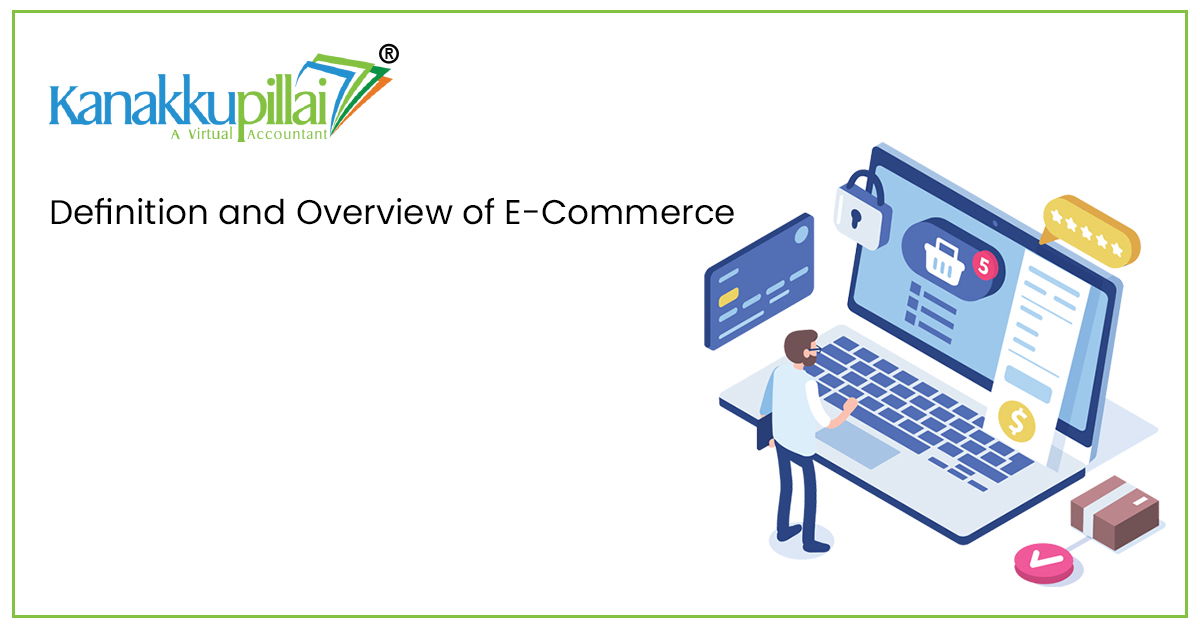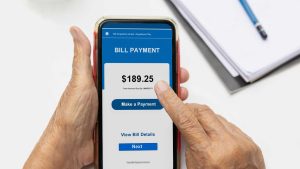![]()
Definition and Overview of E-Commerce
Electronic Commerce which is simplified as E-commerceis the buying and selling of goods and services over an electronic network. And this is mostly done utilizing the internet, and also the transmission of payments and data. It is possible to conduct business-to-business (B2B), consumer-to-consumer (C2C), business-to-consumer (B2C), and consumer-to-business (C2B) transactions. E-commerce and e-business are concepts that are frequently used interchangeable.The transactional procedures that go into the electronic shopping or online retail shopping are also referred to as e-tail.
The widespread dependence on e-commerce platforms such as eBay, Flipkart and Amazon have contributed to significant growth in online retail during the previous decade. E-commerce amounted to more than 5% of overall retail sales in the year of 2007, and now it is amounting to more than 20% of the overall retails.
Working of E-Commerce
Customers would mostly be making use of their own devices to browse an online store and place orders for products or services that are powered by the internet and this can also be for extracting information and data.
As the order is placed, the customer’s web browser will communicate with the server hosting the online store website. The data from the order will be sent to a computer which is the central one and known as the order manager, which will then pass it to databases that control inventory levels, a merchant system that maintains payment information via secure payment gateways, and a bank computer before returning to the order manager. This is done to ensure that the store’s inventory and customer cash are sufficient to complete the order.
The order manager will tell the store’s web server after the order has been validated, and the web server will then show a message informing the customer that their order has been properly processed. In order for the product or service to be effectively sent to the client, the order manager will submit order data to the warehouse or fulfilment department. A consumer may receive physical anddigital items at this time using the platforms, or even be taking an access to a service, which may be granted to them.
Platforms that are hosting e-commerce transactions may also include the electronic and online marketplaces, such as Flipkart.com or the Amazon.com, where sellers can simply sign up. And it also includes the software as a service (SaaS) tool that would allow customers to rent online store infrastructuresor open-source tools that companies can use for managing the in-house development.
Types of E-Commerce Platforms
There are different types of e-commerce platforms that are currently available in the market for the consumers and this would include the following:
Business-To-Business (B2B) E-Commerce
Business-to-business transactions (B2B) is nothing but the electronic exchange or supply of products, services, or information between businesses, rather than between businesses and consumers who are the individuals. supply exchange, online directories and product-basedwebsites are examples of websites that allow businesses to search for services, products, and the data or information, while also initiating transactions via e-procurement interfaces.
This sector is currently growing in a good and highly capacitated manner which is giving scope for setting businesses serving the business consumers and making an ample amount of profit and revenue from the same.
It can be further understood as a business selling a good or service to another business, such as a manufacturer and wholesaler or a retailer. Business to business e-commerce isn’t aimed at consumers, and it frequently involves things such as software’s, raw materials, office stationery items, machineries and equipment’sor combination products. B2B ecommerce allows manufacturers to sell directly to merchants making the process less complex and easier.
Business-To-Consumer (B2C) E-Commerce
The part or segment of e-commerce on the internet which is dealing with the retail sales is known as business-to-consumer (B2C). It occurs when companies sell services, products, or the data or information or a combination of all these to customers directly or even in an indirect manner. The term gained popularity during the late 1990s which is known as the dot-com boom, online shops and sellers of goods were still a novelty.
There are innumerable virtual shops and malls selling a wide range of consumer goods on the internet today. The well-used and knowns examples of these sites areFlipkart, Amazon, or e-baywhich dominates the B2C business.And this also is the most common e-commerce model. When you buy a furniture item from an internet merchant, you are dealing with a business to consumer transaction.
Consumer-To-Consumer (C2C) E-Commerce
Consumer-to-consumer (C2C) e-commerce is another sort of online trading in which individuals trade items or products, their services, and also the data or information with one another. These transactions are typically carried out using a third-party service as that would be providing an online platform for the completion of transactions.
C2C systems include online auctions and classified adplacements, with eBay and Craigslist being two of the more popular examples in this segment.The services provided by the company eBay can be understood as a type of e-commerce that is also known as C2B2C, or consumer-to-business-to-consumer platform. And this majorly is due to the fact that this company is providing varied service.
Thus, we can say that the sale of a good or service to another consumer is referred to as C2C e-commerce. Platforms such as eBay, Fiverr, and others facilitate consumer-to-consumer transactions.
Consumer-To-Business (C2B) E-Commerce
Consumer-to-business (C2B) e-commerce can be understood as the e-commerce setting formed when individuals make their goods and services available for firms to bid on and being bought online. This is the contrary and opposite of the standard B2C business paradigm.
A market that sells royalty-free pictures or medias or design or images and other components, such as iStock, which can be taken as a major example of a C2B platform. An employment board is yet another example for this.When an individual sells their services or products to a business, this is known as consumer to business. Influencers who offer publicity, consultants, freelance writers, photographers, and other C2B professionals are included.
Business-To-Administration (B2A) E-Commerce
Business-to-administration (B2A) refers to internet transactions between businesses and government agencies or departments. Many branches of government, notably when it comes to fiscals, legal documents, social security, registrations, and employment, rely on e-services or goods in some way. Businesses can supply these services via the internet. In recent years, increased investments by the government authorities in the e-government capabilities have resulted in a major increase in B2A services.
Consumer-To-Administration (C2A) E-Commerce
The term “consumer-to-administration” (C2A) refers to internet transactions between private consumers and government agencies. The government rarely purchases goods or services from residents, however they do so frequently in the following areas:
- Education for online lectures or such other services
- Tax filings
- Tax Payments
- Health for making appointment, taking consultations
- Social Security.
Mobile E-Commerce
M-Commerce or the Mobile e-commerceis a fast flourishing and enhancing form of e-commerce that involves online sales transactions conducted by the use or adoption of mobile devices such as smartphones and tablets. Mobile shopping, mobile payments and mobile banking, are all examples of m-commerce or mobile commerce. Businesses can use mobile chatbots to conduct e-commerce transactions, allowing customers to do transactions with businesses via voice or text interactions.
Examples of E-Commerce
Selling of goods and services online is becoming the hottest trend today as people are depending highly on this. Some of the examples of this e-commerce would include the following:
Retail
This majorly includes the selling of the products to the consumers without using an intermediary.
Drop shopping
The sale or the supply of goods that are made and delivered to customers by a third-party service and not the direct service.
Digital Products Sales
Items that can be downloaded but must be purchased, such as courses, templates, courses, paraphrasing or converting tools, software, or movies. Software, tools, cloud-based solutions, and digital assets purchases account for a significant portion of ecommerce transactions.
Wholesale
Bulk products are available for purchase. Wholesale items are often sold to a retail entity, who subsequently sells them to the final consumers or thecustomers.
Service Providing
Writing, coaching, training and influencer marketing are examples of online-purchased and paid-for abilities.
Subscription Based Sales
Customers purchase things or services on a monthly basis through subscription services, which is a prevalent D2C model and here the payment shall also be made on a monthly, quarterly or yearly basis.
Crowdfunding
Sellers can use crowdfunding to raise start-up funds to bring their product to market. The item is made and shipped after a sufficient number of customers having purchased the same.
Benefits of E-Commerce
E-commerce comes with a lot of benefits which can be enjoyed by the sellers and the users. Some of these are listed below:
- Convenience: Shopping online or using e-commerce platforms would make purchases easier, faster, and less time-consuming. And it also makes the same convenient with 24-hour sales, simple returns, and quick shipping,
- Access to Global Market: Customers from all over the world may shop on e-commerce sites, and due to this the businesses are no longer limited by geography or physical obstacles.
- Personalization and Enhanced Customer Experience: E-commerce platforms can develop detailed user profiles that allow them to customise the products they see and provide recommendations for other items they might like. This improves and augments the customer experience by making customers feel understood on a personal level, which increases the likelihood of brand loyalty and frequent purchasing.
- Reduced Cost: Digital retailers can build online storefronts with little start-up and operating costs because brick and mortar are no longer required which consumes major amount of funds setting up the outlet.
Thus can be concluded that e-commerce and online shopping is the new normal in this busy, internet driven and technology driven world. People does not find it convenient to turn to the physical store and spend time for completing their purchase requirements. And with this it has started gaining and giving importance to online selling and buying in every field which has given prominence for B2B and all other types of e-commerce platforms. So, understanding and adopting this would take us also forward as both a seller and buyer.





